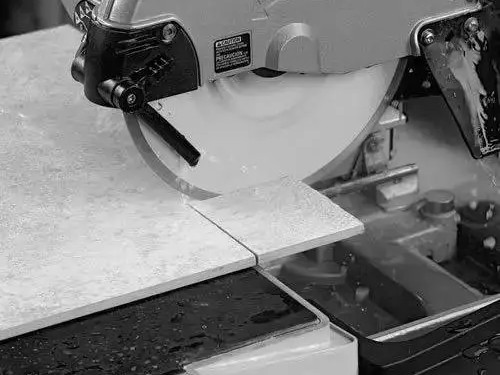
What is the material of the tile cutting saw blade?

When cutting ceramic tiles, the choice of saw blade material is critical to achieving precise and efficient results. Most saw blades used to cut ceramic tile are made of diamond, a material known for its exceptional hardness and durability. In this article, we’ll explore the significance of diamond as the primary material in tile cutting saw blades and its advantages in cutting tile, marble, granite, and other materials.
Diamonds are known for being one of nature's hardest substances, with a hardness scale of 10, and are virtually unaffected by physical and chemical properties. This exceptional hardness and wear resistance make diamond an ideal material for saw blades, especially in applications where accuracy and durability are critical. Using a diamond saw blade offers several key advantages, making it the first choice for cutting a variety of materials, including ceramic tiles.
Diamond saw blade manufacturing process
The manufacturing process of diamond saw blades is a complex and complicated job that involves multiple delicate processes to create high-quality cutting tools. From base material selection to final forging and heat treatment, every step is critical to producing diamond saw blades with exceptional durability, precision, and cutting performance.
The process begins with selecting a high-quality steel plate as the base material for the saw blade. Steel plates are carefully selected considering their strength, durability, and suitability for the intended application. Once the base material is set, it is precision machined to shape it into the dimensions and dimensions required for the specific type of saw blade being manufactured.
After the forming process, the surface of the steel blade is carefully polished to ensure a smooth, even finish. This step is critical to preparing the surface to receive the diamond particles, which are the critical components responsible for the saw blade's cutting ability.
The next critical stage involves the application of diamond particles to the surface of the saw blade. Specialized technology is used to firmly secure the diamond particles to the blade, ensuring they are evenly distributed and firmly bonded to the surface. This meticulous craftsmanship is critical to achieving consistent cutting performance and longevity of the finished saw blade.
Once the diamond particles are in place, the saw blade goes through a forging process to enhance its strength and stability. This step involves subjecting the blade to controlled heat and pressure, resulting in a stronger, more resilient structure. The forging process is critical to ensuring that the saw blade can withstand the rigors of cutting hard materials such as tile, marble, and granite without compromising its integrity.
Finally, the saw blade is heat treated to further enhance its wear resistance and overall performance. This critical step gives the blade extra strength and durability, allowing it to withstand the demands of long-term use cutting tough materials.
Application scope of diamond saw blades
1. Stone: Diamond saw blades are widely used to cut natural stone, including marble, granite, limestone, and other types of stone.
2. Ceramics: In the field of ceramic manufacturing, diamond saw blades play a vital role in cutting ceramic tiles, glass, pottery, and other ceramic materials. Their ability to withstand the hardness of ceramic and provide clean, accurate cuts.
3. Concrete: Diamond saw blades are widely used in the construction industry for cutting concrete materials, including cement pavements, bridges, buildings, and other concrete structures.
4. Metal materials: Diamond saw blades are also used to cut various metal materials, such as aluminum, copper, iron, and other metals.
5. Others: In addition to traditional materials, diamond saw blades are also used to cut fiberglass, plastic, and other composite materials. Their versatility allows them to be used in a wide range of industries that require precision cutting.
The wide application of diamond saw blades extends to construction, stone processing, ceramic manufacturing, automobile manufacturing, and other industries. Their ability to cut a variety of materials with precision and efficiency makes them an indispensable tool for professionals and craftsmen in a variety of industries.
Advantages of diamond saw blades
1. High hardness: Diamond saw blades have unparalleled hardness, several times that of other saw blade materials.
2. Good wear resistance: The high hardness of the diamond saw blade gives it excellent wear resistance, and its service life is significantly longer than other saw blade materials. The extended service life reduces the frequency of saw blade replacements, saving costs and making cutting operations more efficient.
3. Good cutting effect: The diamond saw blade has an excellent cutting effect, the cutting surface is smooth and neat, without burrs or cracks. The precision and consistency of this cutting result make it ideal for achieving high-quality finishes in a variety of applications, from stone processing to ceramic manufacturing and architectural projects.
4. High safety: Although the use of diamond saw blades requires appropriate safety measures, its cutting speed is fast, which reduces the labor intensity and working time of workers.
Precautions when using diamond saw blades
1. Wear safety protective equipment: When using diamond saw blades, it is crucial to wear appropriate safety equipment, including gloves, goggles, and other protective equipment. This helps prevent potential hazards such as flying debris, dust, and sharp edges, ensuring operator safety during cutting operations.
2. Comply with the scope of use: Diamond saw blades can only be used to cut materials within the specified scope of use. It is important to avoid using them for purposes other than those intended, as this may result in reduced cutting efficiency and potential safety hazards.
3. Pay attention to the cutting direction: When using a diamond saw blade, you must pay attention to the cutting direction to avoid applying lateral force during cutting.
4. Maintain environmental hygiene: Diamond saw blades generate noise and dust during the cutting process. It is important to pay attention to environmental hygiene, use dust collection systems, and ensure proper ventilation to minimize the impact of dust and noise on the work environment.
5. Replace expired saw blades: Diamond saw blades have a service life, and it is important to replace them in time after expiration to avoid safety accidents. Using a worn or expired saw blade results in reduced cutting efficiency, increased safety risks, and potential damage to the workpiece.
-
Online service
-
Official wechat
account
-
QQ:40933769
-
E-mail:
sales@z-lion.com
Online service
Please feel free to give your inquiry in the form below. We will reply you in 24 hours.

